Making an imprint on our heritage
Showcasing Canada 150 on federal buildings
Public Services and Procurement Canada plays an important role in the daily operations of the Government of Canada as a key provider of services for federal departments and agencies. The department provides services across Canada through its headquarters in the National Capital Region and through five regional operations.
New stories will be added regularly, so check back often!

Pacific Region
Public Services and Procurement Canada’s Pacific Region is made up of 1 province and 1 territory: British Columbia and Yukon Territory. As part of Canada’s 150th anniversary of Confederation, a total of 6 properties in this region have been decorated with a colorful banner.
Douglas Jung Building
Location: 401 Burrard Street, Vancouver, British Columbia
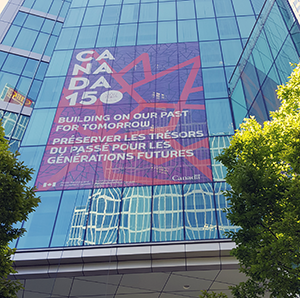
The Douglas Jung Building is a 19-storey skyscraper located in downtown Vancouver. It houses both Environment and Climate Change Canada and Fisheries and Oceans Canada. The building was named in memory of the first Canadian of Chinese heritage to be elected to Canada’s Parliament.
Built in 2002, the Douglas Jung Building is one of Public Services and Procurement Canada’s greenest buildings. It was the first building owned by the government to achieve Leadership in Energy and Environmental Design (LEED) Gold certification in the category Existing Buildings: Operations and Maintenance.
The building has an Energy Star rating of 93. This means that it is more energy efficient than 93% of similar buildings in North America. Some of its green features include:
- natural light, so less indoor lighting is needed
- rainwater recycling to reduce water use
- a reflective roof to reduce heat absorption
- low-flow plumbing fixtures
Sinclair Centre
Location: 757 Hastings Street West, Vancouver, British Columbia
The Sinclair Centre started out as 4 separate heritage buildings that were later joined into 1 building in the early 1980s. An atrium now connects the buildings.
The complex was renamed in 1983 to commemorate James Sinclair, a Canadian politician and businessman.

The 4 buildings that make up the Sinclair Centre were built at different times.
The Post Office
The Post Office was designed by David Ewart. It was built between 1905 and 1910 and is similar in style to other large federal buildings of the era.
The Post Office was built with a large electric clock that people were able to see from all parts of the city.
Today, the original bell and clock, built in 1909, sit above the centre of the Sinclair Centre atrium. It is the largest clock movement in Western Canada. Its minute hand alone weighs more than 90 kilograms.
The Winch Building
Built in 1911, this was the first commercial building west of Granville Street. The federal government bought the building in 1925 to make room for its growing post office operations.
The Customs Examining Warehouse
The warehouse was built in 1913. It was made because demand for imported goods was going up, so the government needed space to inspect the goods coming in.
The Federal Building
The building was built between 1935 and 1937. It was built to make room for growing postal operations, as well as to provide office space for other government departments. The new building was built as an extension to the Post Office. It replaced several buildings and made the entire city block 1 government-owned property.
Interesting fact:
The fish engraved on the medallions on the east side of the Post Office are sturgeon. Sturgeon used to be considered a royal fish. Tradition said that any sturgeon caught in the United Kingdom had to be presented to the king or queen. Sturgeon medallions later came to symbolize Crown-owned property.
The merging of these 4 heritage buildings was one of the largest conservation projects that the federal government had ever done outside of Ottawa. The project was conceived, developed and managed by the Department of Public Works (one of the departments that became Public Services and Procurement Canada). The restoration was completed for Vancouver’s 100th birthday and Expo 86.
Elijah Smith Building
Location: 300 Main Street, Whitehorse, Yukon
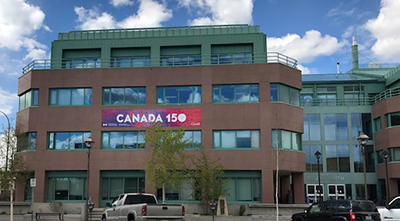
Elijah Smith was a pioneer for Yukon First Nations. He led negotiations with the federal government to ratify land claims agreements. Smith was the founding president of the Yukon Native Brotherhood. He was also the founding Chairperson of the Council for Yukon Indians, which was later renamed the Council of Yukon First Nations. Thanks to these organizations, Yukon First Nations ultimately regained self-governance.
Before the agreement, Yukon First Nations had been struggling to protect and control their land. At the height of the Klondike Gold Rush, the Chief of the Ta’an Kwach’an asked the Canadian government for compensation for lost land and the impacts on wildlife. The federal government did not act on the request. In 1973, the Yukon Native Brotherhood, led by Smith, wrote “Together Today For Our Children Tomorrow.” Smith presented the document to the Prime Minister, and negotiations finally took place.
The Umbrella Final Agreement was signed in 1993 as the framework for negotiating individual agreements with each of the 14 Yukon First Nations. The land claims agreements were ratified in 1995. As a result, the Yukon First Nations were returned a portion of their land and given the right to self-govern.
To honour this important Canadian citizen, the prominent 4-storey office building in Whitehorse was renamed the Elijah Smith Building.
Library Square
Location: 300 Georgia Street West, Vancouver, British Columbia
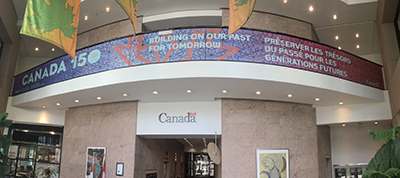
Library Square was built in 1995. Its unique design was inspired by the Coliseum in Rome.
The square is made up of:
- the Central Branch of the Vancouver Public Library
- a 21-storey office tower
- retail shops
- restaurants
A total of 18 Government of Canada departments and agencies have offices in the high-rise office tower.
The office tower was not part of the original design of the building. It was added to help pay for the building’s construction. The federal government made an agreement with the City of Vancouver to lease and then purchase the high-rise portion of the building. The space rented in the office tower helped pay for the $157-million construction project.
Interesting fact:
Library Square stretches an entire city block. On the ninth floor of the building, there is a green roof.
Esquimalt Graving Dock
Location: 825 Admirals Road, Esquimalt, British Columbia
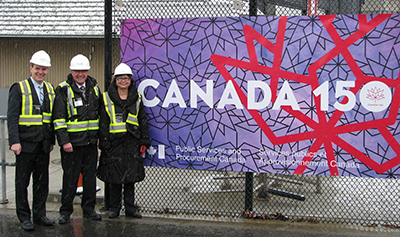
Representing 60% of Canada’s Pacific Coast dry dock capacity, the Esquimalt Graving Dock services a wide variety of vessels. The term “graving” means to scrape off barnacles and material from the hull of a ship.
The Esquimalt Graving Dock measures 357 metres by 38 metres and is the largest deep-sea shipbuilding and repair facility in the region. It is located at the south end of Vancouver Island at Esquimalt Harbour, in the Greater Victoria region.
This world-class facility includes high-speed cranes that can lift up to 165 tonnes. It also includes stabilizer pockets, which enable cruise ships to extend their stabilizers for inspection, maintenance and repair while in dry dock.
The dock can accommodate ships of various sizes. It has room for ships so large that they can safely carry up to 100,000 tons (deadweight tonnage).
The Esquimalt Graving Dock is used by:
- the Royal Canadian Navy
- the Canadian Coast Guard
- BC Ferries
- several foreign and private vessel owners
The facility is used primarily for repairing, maintaining and refitting ships. Refitting ships means to fix, restore, renew or renovate an old vessel.
The Esquimalt Graving Dock plays a vital role in the West Coast marine sector. The dock operates 24 hours a day, 7 days a week, and 365 days a year. The graving dock has an estimated economic impact of $200 million annually. It supports about 1,300 well-paying jobs.

Western Region
Public Services and Procurement Canada’s Western Region operations includes the following provinces and territories: Alberta, Saskatchewan, Manitoba, Northwest Territories and Nunavut. Banners of all shapes and sizes are installed on 7 buildings across the region. Check them out!
Saskatoon Federal Building
Location: 101 22 Street East, Saskatoon, Saskatchewan

The Federal Building was designed and built by the Department of Public Works (one of the departments that became Public Services and Procurement Canada [PSPC]). It was built under the supervision of the department’s Chief Architect T.W. Fuller. Construction began in early spring of 1929. When the building first opened in 1931, it housed the offices of the federal government in Saskatoon, including the central post office.
The Federal Building was considered “the most modern public building in Saskatoon.” A newspaper clipping from May 2, 1931, states that the building’s cleaning system “cannot be excelled.” The clipping highlights: “a huge central vacuum cleaning plant which picks up dust from any floor in the building, carrying it through pipes to a mighty container in the basement.”
PSPC has repaired and upgraded the Federal Building. The department did an extensive renovation of the interior in 1961. Frank Martin was the architect for the renovation.
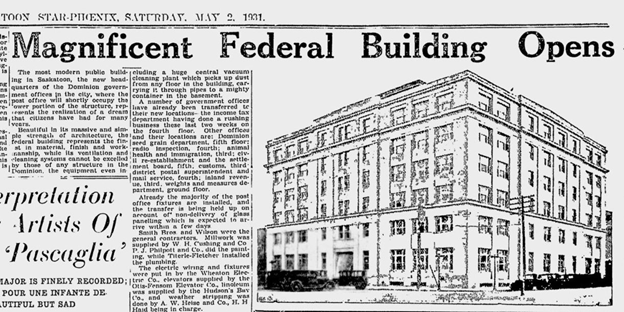
Source: City of Saskatoon Archives
Image description
A clipping from the Saskatoon Star-Phoenix on Saturday, May 2, 1931, shows a sketch of the Saskatoon Federal Building.
RCMP K Division Headquarters
Location: 11140 109 Street NW, Edmonton, Alberta
The original headquarters building for the Royal Canadian Mounted Police (RCMP) K Division was built in Edmonton in 1957. The building was replaced in the late 1990s.
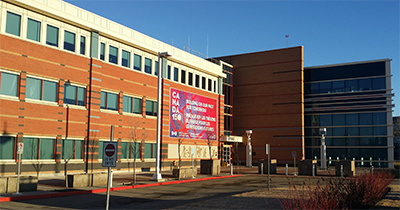
The current headquarters boasts many special features, including:
- a multimedia centre
- an officer's mess
- 40-room barracks
- a fitness centre
- a forensic identification lab
- a firing range
- training facilities
- a full-service medical clinic
Interesting fact:
There is a plaque on the building honouring an RCMP dog who died in the line of duty. Quanto was a 5-year-old service dog. The plaque is located beside the employee entrance to the K Division Headquarters.
Qimugjuk Building
Location: 1030 Federal Road, Iqaluit, Nunavut
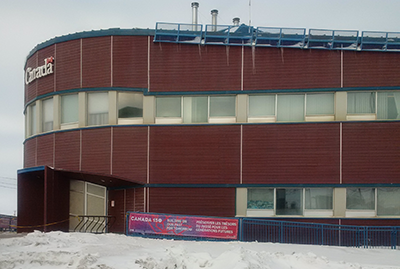
The Qimugjuk Building was constructed between 1999 and 2000. The building was built as a flagship property for the Government of Canada in Iqaluit. It was built in the capital of what was then the newly created Nunavut Territory. Federal organizations in the building include:
- Indigenous and Northern Affairs Canada
- the Royal Canadian Mounted Police
“Qimugjuk” is the Inuktitut word for a snowdrift that tapers off gradually to the ground.
“Iqaluit” is Inuktitut for "place of many fish." It is located near the mouth of the Sylvia Grinnell River, which empties into Frobisher Bay. Between 1955 and 1987, the community was known as Frobisher Bay. Its name came from the English explorer Martin Frobisher, who sought the Northwest Passage.
Alvin Hamilton Building
Location: 1783 Hamilton Street, Regina, Saskatchewan

The Alvin Hamilton Building was built in 1968. It is located on Hamilton Street in downtown Regina and used to be called the Galleria Building. The Government of Canada purchased the building in 2002. It was then renovated to accommodate federal departments and agencies, and to provide a one-stop shop for federal government services in downtown Regina.
As part of the renovation, the building was made more environmentally friendly. In fact, it was the first federal project in Regina to earn Silver certification under the Leadership in Energy and Environmental Design (LEED) rating system.
Harry Hays Building
Location: 220 4 Avenue SE, Calgary, Alberta

The Harry Hays Building is a federal office building in downtown Calgary. Looking through windows on the north side of the building, you’ll get spectacular views of the Bow River and Calgary’s cityscape.
The building is named after Harry William Hays. Hays was the federal Minister of Agriculture from 1963 to 1965. He was a senator from 1966 up until his death in 1982. Before he joined politics, Hays led the Canadian Swine Breeders during the Second World War. Under his leadership, the breeders started the "Bacon for Britain" campaign to increase production as part of the war effort. In the 1950s, Hays pioneered exporting cattle by airplane. This allowed the Canadian industry to develop new markets in Mexico and the United Kingdom.
Building tenants include the Canada Revenue Agency, Service Canada and Passport Canada, and Health Canada.
Victory Building
Location: 269 Main Street, Winnipeg, Manitoba

In 2005, the Federal Building in Winnipeg was renamed the Victory Building. The name was changed to:
- honour Canadian veterans
- commemorate the 60th anniversary of the end of the Second World War
The building was built between 1935 and 1936. This was 1 of the 2 largest buildings built as part of Canada’s Public Works Construction Act of 1934. The building program was put in place to stimulate the economy and get the unemployed back to work during the Great Depression.
The Federal Building was designed to house the offices of several government departments in 1 location. Currently, tenants in the building include:
- Immigration, Refugees and Citizenship Canada
- Canada Border Services Agency
- Canadian Food Inspection Agency
The Victory Building is a landmark on Winnipeg’s Main Street.
Interesting fact:
The top floor of the 7-storey tower was at one time used to house workers who shovelled coal into the furnace that heated the building.
Greenstone Building
Location: 5101 50 Avenue, Yellowknife, Northwest Territories
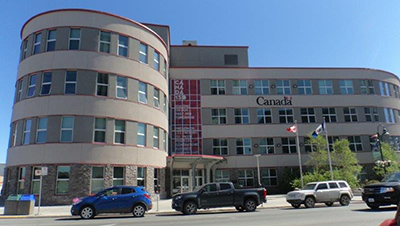
This 4-storey structure located in downtown Yellowknife provides office space for 200 federal employees from a number of departments.
Construction was completed in 2007. The building is certified Leadership in Energy and Environmental Design (LEED) Gold. It is estimated to use 50% less energy than a comparable building.
Green features include:
- high-efficiency propane boilers with lower greenhouse gas emissions than the usual fuel oil furnaces
- a high-efficiency air-cooled condensing chiller
- a south-facing glass curtain wall that has solar cells embedded in it to collect solar power
- light and warmth that come in from the windows help maintain a comfortable working temperature inside the building, even in the middle of winter when outside temperatures can drop to -50°C
- hot water heated by solar energy
- triple-pane windows that can open and close
- waterless urinals, duel-flush toilets and low-flow faucets and showers, which mean the building uses about 50% less water than a comparable building
- a green roof
- a cistern to collect rain and groundwater
- water from the cistern is used for landscaping and to flush toilets
Canada Place
Location: 9700 Jasper Avenue, Edmonton, Alberta

Canada Place was built between 1985 and 1988 and houses federal government offices in Edmonton. The 2 office blocks, which are shaped like steps, are 13 and 15 storeys in height and overlook the North Saskatchewan River valley. The 2 blocks are connected by an atrium.
The original design of the building also had a taller third office block at the rear. However, this plan was scaled back to 2 blocks because at the time, the office occupancy levels in downtown Edmonton were too low to justify the larger building.
Interesting fact:
The building is distinguishable from other buildings in downtown Edmonton because of its pink colour and stepped shape. When the sun rises in the winter, the rays hit the pink glass-sheathed building, creating a unique reflection.

Ontario Region
The Ontario Region of Public Services and Procurement Canada includes all of the province of Ontario, except Ottawa. A total of 6 federal buildings in the Ontario Region have been chosen to feature Canada’s 150th anniversary building banner. Read the short stories below to learn about the interesting history of the buildings and the famous Canadians they’re named after.
Laura Secord Building
Location: 32 Church Street, St. Catharines, Ontario
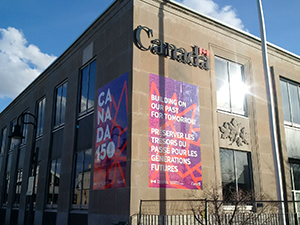
This building is named after Laura Secord. Despite the fact that her contributions to the War of 1812 were little known during her lifetime, this Canadian heroine has been recognized many times since her death in 1868. One of those times was on October 29, 2012. Public Services and Procurement Canada renamed the federal heritage building in St. Catharines, Ontario, in her honour.
Secord played a vital role during the War of 1812. To warn British forces that the Americans were planning an attack on Beaver Dams, she walked more than 30 kilometres out of lands that were occupied by the Americans. Secord set out from her home on the dangerous mission. She travelled behind enemy lines through fields and forests, struggling to make it to the De Cew farmhouse. Once she got there, she told Lieutenant James FitzGibbon about the Americans’ plan.
Thanks to her warning, FitzGibbon was able to prepare an attack plan involving warriors from the Seven Nations of Canada. This ultimately led the British to victory.
Today this government-owned building, built in 1956, honours Laura Secord as a major contributor in Canada’s history.
Old Kingston Post Office
Location: 86 Clarence Street, Kingston, Ontario
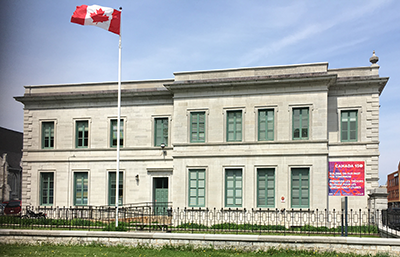
The Old Kingston Post Office is a two-storey limestone building in downtown Kingston, Ontario. The post office was built by local builders Overend and Matthews between 1856 and 1859. The Department of Public Works later added an extension. The neoclassical-style building was designated a national historic site in 1971.
Interesting fact:
After a devastating fire raged through Kingston in 1840, constructing wooden buildings was banned. Most buildings built after the fire were made of stone and brick. This gave Kingston the nickname “limestone city.”
Sir Isaac Brock Building
Location: 55 Bay Street, Hamilton, Ontario
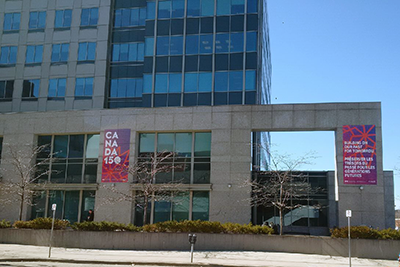
After the United States declared war on Great Britain in 1812, Major-General Sir Isaac Brock took it upon himself to defend Upper Canada. He commanded an army of 1,330 men. Brock successfully led a counterattack on Detroit, even though his army was greatly outnumbered. After the battle, he was hailed the “hero of Upper Canada.” Brock was killed in the Battle of Queenston Heights on October 13, 1812. He and his army were trying to stop an American invasion at the Niagara border. Thanks to Brock’s victories at Detroit and Queenston Heights, the borders of Upper Canada were protected from American invasion through the next two years of war.
The federal building at 55 Bay Street in Hamilton, Ontario, was named the Sir Isaac Brock Building. The name was given in honour of Brock’s role in the War of 1812. The building is located just a few kilometres away from the site of the historic Battle of Queenston Heights.
The building was built in 2003, and the Government of Canada bought it in 2008. This building now houses federal government offices, including Public Services and Procurement Canada. It’s also home to a number of businesses.
Arthur Meighen Building
Location: 25 St Clair Avenue East, Toronto, Ontario
The Arthur Meighen Building is located in the busy midtown Yonge and St Clair hub in Toronto. It’s named after the ninth Prime Minister of Canada, Arthur Meighen. The Canadian lawyer and politician was born in 1874 on a farm in Perth County, Ontario. Meighen practised law before being elected to the House of Commons, where he held several important Cabinet positions in Robert Borden’s ministry. He became Prime Minister in 1921 and held the office again in 1926. Meighen is recognized for his achievements as Cabinet minister and his gift for parliamentary debate. He helped create the Canadian National Railway by merging several bankrupt railways. Meighen later served in the Senate before retiring from politics to work in Toronto.
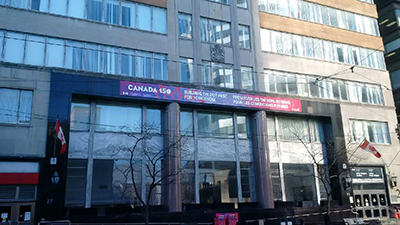
The building at 25 St Clair Avenue East is being renovated to serve as the main Government of Canada building in the Ontario Region. The interior will be designed using activity-based workplace principals. This new workplace design aims to:
- create a modern office space
- attract and retain employees
- use space at least 63% more efficiently
The building is one of the first federal buildings that the Government of Canada is looking at making carbon neutral. The renovations are planned for completion in 2022, when client departments can move in.
Dominion Public Building
Location: 457 Richmond Street, London, Ontario
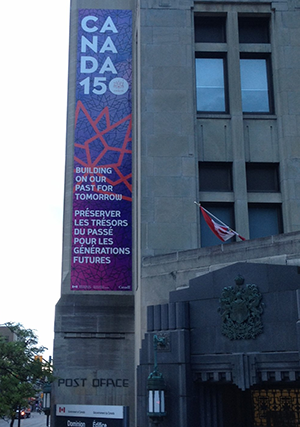
The Dominion Public Building is located in London. It was built between 1935 and 1936, during the Great Depression. It was 1 of 26 federal buildings built under the Public Works Construction Act of 1934. This federal government program aimed to ease the effects of the Depression. The $40-million program was designed to stimulate the economy and get the unemployed back to work.
The original tenants of the building included:
- Postal Department
- Department of Labour
- Customs Department
- Royal Canadian Mounted Police
- Department of National Revenue
- Department of Public Works
Today, the ground floor of the building serves as the city’s Service Canada Centre. It’s the main point of contact for citizens seeking government information and services in London.
The building’s upper floors provide office space for federal workers from Employment and Social Development Canada, Health Canada and Public Services and Procurement Canada.
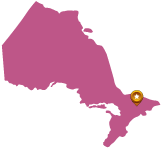
National Capital Region
The National Capital Region (NCR) is the area encompassing Ottawa, Ontario, and the neighbouring city of Gatineau, Quebec. It is home to some of Canada’s most prominent buildings, such as those on and around Parliament Hill. Discover more about the 4 buildings in the NCR that are boasting new Canada 150 banners by clicking on the links below.
Place du Porage III
Location: 11 Laurier Street, Gatineau, Quebec
Portage III was constructed between 1973 and 1978 as part of the Place du Portage complex. The federal government began building the complex in 1970. It was part of an effort to disperse its government workforce throughout the National Capital Region. Place du Portage consists of 4 phases.

Portage III (formerly known as Phase III) is located in Gatineau, along the Ottawa River. The facility consists of:
- 6 sections of different heights
- a commercial area
- 2 basement levels
- a tri-level underground parking garage
Portage III serves as the headquarters for Public Services and Procurement Canada and provides office space for approximately 4,500 public servants. A total of 9 retail tenants occupy the commercial area.
With its 4 phases combined, Place du Portage is the biggest office complex in the National Capital Region.
Terrasses de la Chaudière
Location: 15 to 25 Eddy Street, 10 Wellington Street and 1 Promenade du Portage, Gatineau, Quebec
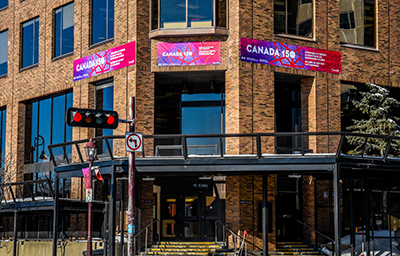
Terrasses de la Chaudière is a complex of government office buildings. It was built between 1976 and 1978 as part of Prime Minister Pierre Trudeau’s initiative to increase the number of federal workers on the Quebec side of the Ottawa River. The building is named after the nearby Chaudière Falls.
The building’s 3 towers house a total of 6,500 federal government office workers. Its tenants include:
- Indigenous and Northern Affairs Canada
- Canadian Heritage
- the Canadian Transportation Agency
- Public Services and Procurement Canada
- Shared Services Canada
- the Canadian Radio-Television and Telecommunications Commission
Interesting fact:
The central tower of the Terrasses de la Chaudière complex is the tallest in the National Capital Region. Its 30 floors reach a height of 124 metres.
John G. Diefenbaker Building
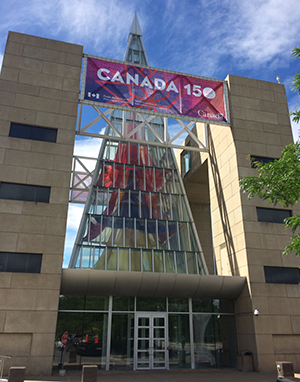
Location: 111 Sussex Drive, Ottawa, Ontario
This building was renamed in 2011 after Canada’s 13th Prime Minister, John George Diefenbaker. Diefenbaker was Prime Minister from June 21, 1957, to April 21, 1963. He:
- championed the Canadian Bill of Rights
- gave all Aboriginal people the right to vote
- appointed the first woman to the Cabinet
- appointed the first Aboriginal person to the Senate
This prominent Ottawa building honours an iconic Canadian leader who played a vital role in Canada’s history.
The building served as Ottawa’s city hall from 1958 to 2000. The Government of Canada purchased it in 2003.
Postal Station B
Location: Postal Station B, Ottawa, Ontario
On the evening of December 6, 2016, work began to install a building wrap around Postal Station B, located prominently at the corner of Sparks and Elgin streets in Ottawa. Public Services and Procurement Canada is rehabilitating this heritage building to address critical deterioration and to ensure the health and safety of building occupants, shoppers and pedestrians.
This isn’t just any ordinary building wrap! This one has been designed to reflect the Canada 150 celebrations occurring throughout 2017. Departmental employees were there every day to capture the installation process as a time-lapse video of the installation of tarps on Postal Station B. You can also check out the photos on Public Services and Procurement Canada’s Facebook page.

Quebec Region
Public Services and Procurement Canada’s Quebec Region encompasses the entire province of Quebec, except for an area within a 20-to-25-kilometre radius of Gatineau. A total of 6 buildings across Quebec have been chosen to boast banners during Canada’s big year.
Normand Maurice Building
Location: 740 Bel-Air Street, Montréal, Quebec
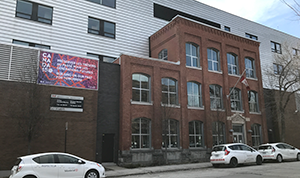
Public Services and Procurement Canada (PSPC) led the construction of the Normand Maurice Building. The 38,700-square-metre facility was built between 2002 and 2005. It was built on the site of an old foundry. To preserve the heritage, the original façade of the foundry was made a part of the new building. The old façade serves as the main entrance of the building. The building was designed and constructed to be environmentally friendly and energy efficient.
It is the first federal building in Quebec designed to meet the ecological goals of the Canadian government.
Some of its green features include:
- geothermal wells to tap the heating and cooling capacity of the earth
- radiant heating and cooling rather than cooling or heating the ventilation air only
- brise-soleils (louvered sun shades) to shut out excessive sunlight so it doesn’t get too hot in the building in the summer
- 5 skylights to increase natural lighting
- a green roof
- rainwater used to flush toilets
- bicycle storage and change facilities to encourage alternative forms of commuting
- some materials from the pre-existing foundry were used in the new building to reduce waste
This building is truly leading the way towards sustainable development. It is one of the first buildings in Quebec to receive Leadership in Energy and Environmental Design (LEED) Gold certification. The Normand Maurice Building is also one of PSPC’s most energy-efficient buildings ever built.
Léonce Lessard Building
Location: 1420 Sainte-Catherine Street West, Montréal, Quebec
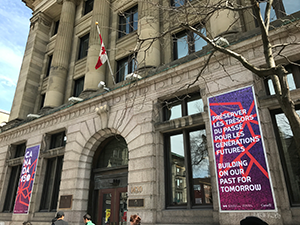
The Léonce Lessard Building was built between 1913 and 1914 and is located on Sainte-Catherine Street West in Montréal. It used to be a postal facility called Postal Station H. The Department of Public Works (one of the departments that became Public Services and Procurement Canada) designed and built the building in a Beaux-Arts style. The Dominion Armorial Crest, a bronze sculpture made up of a shield in central ornament, appears on the roof of the building, overlooking the main façade. The shield contains:
- the coat of arms of the 7 provinces and the 2 territories making up the Dominion of Canada
- a crown similar to the one worn by Edward VII at the time of his coronation in 1902
- a lion and a unicorn, animals of the Royal Coat of Arms of Great Britain
- an orb or globe of gold, an object that symbolizes royalty and that the King of England held during his coronation
The building is recognized as a federal heritage building. Postal Station H was one of many public buildings built by the federal government to serve the needs of Canada’s growing population. The Léonce Lessard Building now houses National Defence.
Gare du Palais Building
Location: 300 De La Gare-du-Palais Street, Québec, Quebec
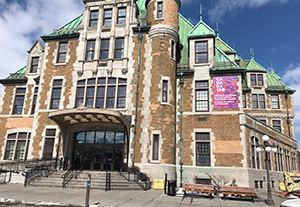
The building located at 300 De La Gare-du-Palais street is right next to the former Canadian Pacific Railway station known as the Gare du Palais. It was built between 1939 and 1940. The structure is 7 storeys high and was designed by Raoul Chênevert in a Château style.
The building was the postal station in Québec’s Lower Town. It reflects the development of postal services in Canada. It is closely associated with the importance of Québec as a postal terminus in the 18th century.
Louis S. St-Laurent Building
Location: 3 Du Chien-d’Or passage, Québec, Quebec
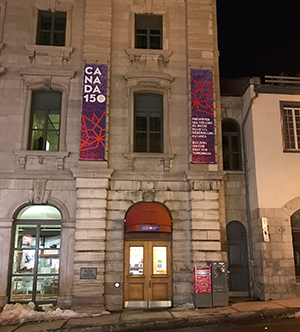
The Louis S. St-Laurent Building is named in honour of Louis Stephen St-Laurent, who served as Prime Minister from 1948 to 1957. The building is located near the top of the côte de la Montagne in Québec and was built between 1872 and 1873. Its construction marked an important step in the creation of an international postal communications network. The building is one of the few post offices of this era to survive. It still houses a post office today. The Louis S. St-Laurent Building is classified as a federal heritage building because of its:
- important history
- Beaux-Arts architectural style
- location in the urban setting of Québec’s Upper Town
Interesting fact:
There is an image called the Golden Dog carved into the stone in the front of the Louis S. St-Laurent Building. William Kirby wrote about it in his 1865 novel, The Golden Dog. The dog carved on this building has been chewing its bone in that same location since 1766. The image of the dog has been featured on the façade of the different buildings in this location over the years.
Custom House
Location: 130 Dalhousie Street, Québec, Quebec
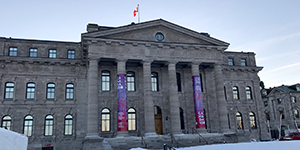
When it was first constructed, this building was named the New Custom House because it replaced the Old Custom House. Eventually, the terms “old” and “new” could no longer be referenced in time, and the name became simply Custom House. The Custom House in Québec was built between 1856 and 1860. It was built at Québec’s busy port on the St. Lawrence River. The Government of Canada built it because it needed more room for managing customs on goods coming into Canada.
William Thomas, a prominent Toronto architect, designed the building. The Custom House building is a perfect example of neoclassical design enhanced with a rich layer of Italianate detailing. Its design is one of the reasons it was designated a national historic site. Fires in 1864 and 1909 damaged the building’s dome and interior. The building’s final reconstruction took place between 1910 and 1911. An additional storey and a new shorter dome were built. The dome’s appearance has changed a total of 3 times since its construction. From 1979 to 1983, the building was entirely restored as part of the redevelopment of the Old Port.
Guy Favreau Complex
Location: 200 René-Lévesque Boulevard West, Montréal, Quebec
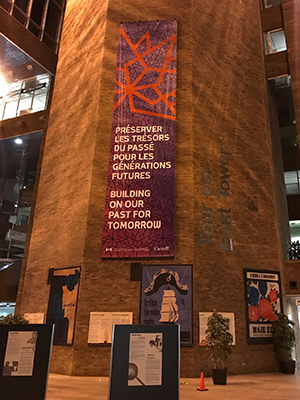
The Guy Favreau Complex is the federal government’s main building complex in Montréal. It was built in 1983 with an overall cubist look. The complex is made up of 2 office towers and 4 residential towers. It was named after a prominent Montréal lawyer, politician and judge.
Guy Favreau had many roles in the federal government. He served as:
- Minister of Citizenship and Immigration
- Minister of Justice and Attorney General of Canada
- President of the Privy Council
- Registrar General of Canada
- Leader of the Government in the House of Commons
- Liberal Party House Leader
Favreau was appointed President of the Privy Council in 1965. Shortly thereafter, he disappeared from the public view, his health failed, and he died in 1967.
Interesting fact:
The Guy Favreau Complex is part of Montréal’s 33-kilometre underground city called “RÉSO.” Underground tunnels in downtown Montréal connect many of the city’s buildings. There are approximately 500,000 people who walk through them every day. RÉSO contains the largest network of covered galleries in the world.

Atlantic Region
Public Services and Procurement Canada’s Atlantic Region operations includes the provinces of New Brunswick, Nova Scotia, Prince Edward Island and Newfoundland and Labrador. A total of 5 buildings in this region are decorated with Canada 150 banners.
Jean Canfield Building
Location: 191 Great George Street, Charlottetown, Prince Edward Island
The Jean Canfield Building is a 4-storey structure that provides office space for about 500 government employees from several departments and agencies.
It is an environmentally friendly building built by Public Services and Procurement Canada. Construction was completed in 2007.
The building is certified Leadership in Energy and Environmental Design (LEED) Gold. It is estimated to use 57% less energy than a comparable building.

Green features include:
- solar panels to capture energy from the sun
- the south wing of the building is skewed 45 degrees to optimize the solar exposure
- high-efficiency heating, cooling and ventilation systems
- high levels of insulation
- windows that open and close
- rainwater used for toilets
- low-flow water fixtures and waterless urinals
- stormwater management incorporated into the design
- accessible by public transit
- bicycle storage and change facilities to encourage alternative forms of commuting
The building is named after Ella Jean Canfield, the first female member of the Prince Edward Island Legislative Assembly and the first woman to sit in the provincial cabinet.
Dominion Public Building
Location: 1081 Main Street, Moncton, New Brunswick
The Dominion Public Building is located in downtown Moncton. The Beaux-Arts style building was built from 1934 to 1936. Along with many other dominion public buildings throughout Canada, it served the growing functions of the federal government.
The Dominion Public Building in Moncton is 4 storeys. Its main entrance continues to showcase the original door and hardware of the building.
Today, the main floor of the building still resembles the post office that used to be located there. The marble floors and brass wickets in the lobby have remained relatively unchanged. They help retain the building’s heritage appeal. The building provides office space for workers from several government departments, such as:
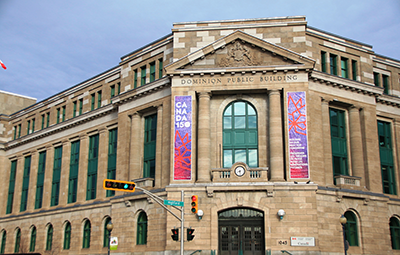
- Public Services and Procurement Canada
- Employment and Social Development Canada
- Correctional Service Canada
- Innovation, Science and Economic Development Canada
- Canadian Heritage
- Shared Services Canada
- Health Canada
- the Parole Board of Canada
- the National Film Board of Canada
- Parks Canada
- the Canadian Food Inspection Agency
RCMP J Division Headquarters
Location: 1445 Regent Street, Fredericton, New Brunswick
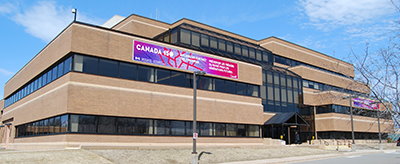
The Royal Canadian Mounted Police (RCMP) refers to its organization in New Brunswick as “J Division.” The RCMP began providing provincial policing services in 1932. Its first headquarters was set up in Fredericton at the Old Government House. The headquarters brought together 127 members from 3 different organizations:
- the RCMP
- the former New Brunswick Provincial Police
- the Federal Preventative Services
In 1988, the J Division Headquarters moved from the Old Government House into a new complex at the top of Regent Street in Fredericton.
Marine House
Location: 176 Portland Street, Dartmouth, Nova Scotia
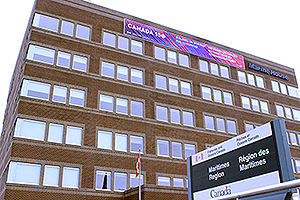
Marine House is a 6-storey building built in 1984 in downtown Dartmouth. It was built by a private company to house medical offices. The federal government began renting office space in the building in the late 1990s and bought the building in 2002.
The building used to be the Maritimes Region headquarters of Fisheries and Oceans Canada. The building is vacant right now. A major project to update the interior is planned before new tenants move in.
Sir Humphrey Gilbert Building
Location: 165 Duckworth Street, St. John’s, Newfoundland and Labrador
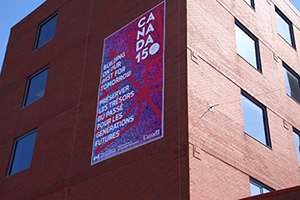
The Sir Humphrey Gilbert Building was built in 1959. It was designed by Lawson, Betts and Cash, along with A.J.C. Paine.
The building was named in honour of Sir Humphrey Gilbert. Gilbert was an explorer, an adventurer and a writer. He published a book called “A Discourse of a Discoverie for a New Passage to Cataia.” The book was about finding a Northwest Passage to China. Gilbert presented his idea to Queen Elizabeth in London, England, in 1573.
In 1578, the Queen gave Gilbert a 6-year exploration licence that authorized him to colonize the coast of North America. After many failed attempts at setting sail, Gilbert finally arrived at the port of St. John’s. He formally took possession of Newfoundland in 1583. Gilbert was the founder of the first English colony in North America.
- Date modified: